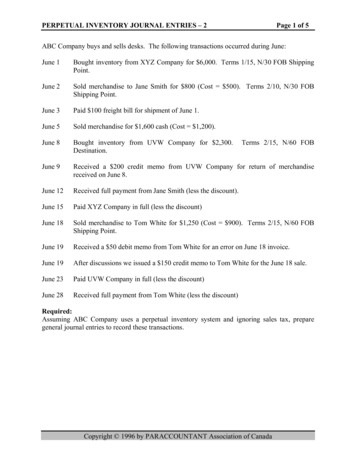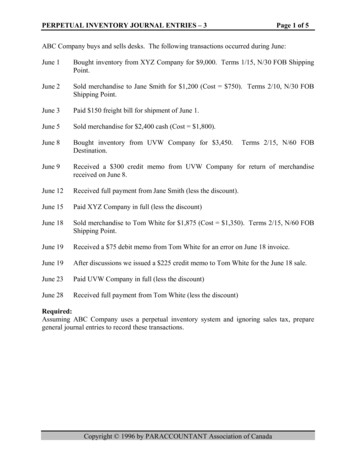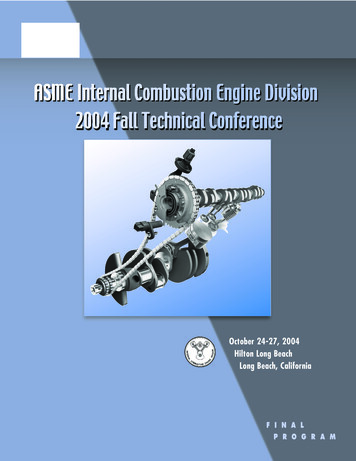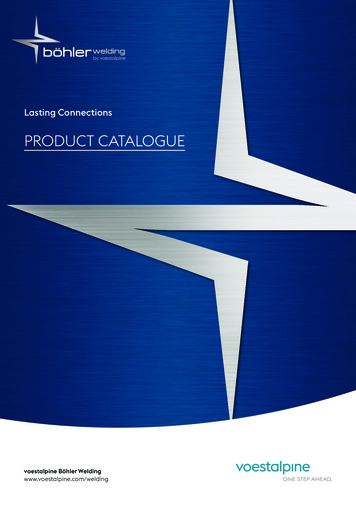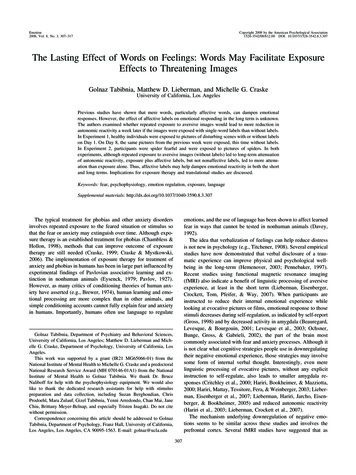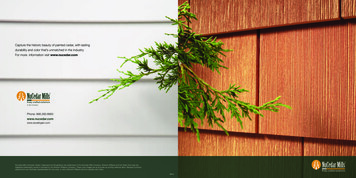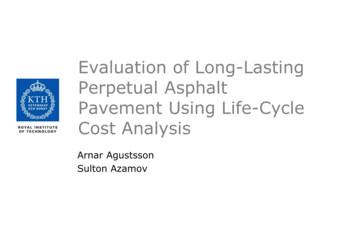
Transcription
Evaluation of Long-LastingPerpetual AsphaltPavement Using Life-CycleCost AnalysisArnar AgustssonSulton Azamov
Contents1.2.3.4.5.6.7.8.9.Perpetual Asphalt PavementScopeMethodologyPerformanceAlternatives for the Life Cycle Cost AnalysisResultsConclusionsCriticismReferences2
Perpetual Asphalt Pavement Defintion- “an asphalt pavement designed and built to last longerthan 50 years without requiring major structuralrehabilitation or reconstruction, and needing only periodicsurface renewal in response to distresses confined to thetop of the pavement.”Asphalt Pavement Alliance, 20103
Perpetual Asphalt PavementNational Asphalt Pavement Association, 20104
Perpetual Asphalt Pavement Advantages- Longer lifetime- Lower user cost- No structural repairs necessary Shorter construction time– Less user delay Lower repair costs Disadvantages- Higher initial cost5
Scope Compare and analyze two sections of pavement- 14 inches thick perpetual pavement (Section N9)- 10 inches thick AASHTO pavement (Section N8) With regards to- Life cycle cost- Performance Sponsored by the Oklahoma Department ofTransportation (OKDOT)6
Methodology – Test Track Tests conducted 2006-2011- National Center for Asphalt Technology Pavement TestTrack in Auburn, Alabama Loading simulated on the test track- Accelerated Pavement Testing (APT)– 55 years usage analyzed in 5 years– 20 million ESALs- 5 trucks drive 400 rounds per day Shortcomings- Accelerated loading– Aging not considered- Only 5 trucks used in testing– Does not represent actual traffic7
Methodology – Life Cycle CostAnalysis Life cycle cost analysis performed RealCost 2.5- Developed by the Federal Highway Administration(FHWA)- Determined User cost Agency cost Pavement design using PerRoad- Considers different pavement materials to determineoptimal thickness8
Performance – Original design of N9 2 inches thick stone matrixasphalt surface (SMA) 9 inches of dense asphaltconcrete layer 3 inches rich asphalt concrete 7 inches thick stiff soil base Aggregates and soil importedfrom Oklahoma for moreaccurate simulation Designed using PerRoadsoftware9
Performance – Original design of N8 2 inches thick stone matrixasphalt surface (SMA) 6 inches dense Superpave mix 2 inches rich asphalt concrete- 2% air voids in order to get highbinder content 7 inches thick stiff soil base Aggregates and soil importedfrom Oklahoma for moreaccurate simulation Designed according to AASHTO1993 Pavement Design Guide10
Performance – Rehabilitation 1 Surface cracks after 8,3 millionESALs- Rehab needed after 10 millionESALs Rehabilitation- Top 5 inches milled- Replaced with 2 inches SMA and3 inches of Superpave mix withpaving fabric in-between Performance- Very poor- Failed after 3,5 million ESALs11
Performance – Failure after rehab 112
Performance – Rehabilitation 2 After 13,5 million ESALS Rehabilitation- Top 5 inches milled- Replaced with thin layer of richbottom of rich High-PolymerContent Mix (HPM) covered with4 inches of HPM with 4% airvoids Performance- Minimum rutting and no crackingafter 5,5 million ESALs13
Performance14
Performance15
Performance - Summary Section N8-Built 2006Rehabilitation 1 in 2009 (10 million ESALs)Rehabilitation 2 in 2010 (13,5 million ESALs)No problems after rehabilitation 2 Indicates that the high-polymer mixture performs better thanstone matrix asphalt Section N9- Built 2006- No treatment needed- Good, consistent performance16
Alternatives for the Life Cycle CostAnalysis Alternative 1 – N8- Rehab 1 using SMA- Rehab 2 & and 3 using HPM Alternative 2 – N8- Rehab 1, 2 & 3 using SMA Alternative 3 – N8- Rehab 1,2 & 3 using HPM Alternative 4 – N9- Rehab 1,2 & 3 using SMA17
ResultsAlternativesUndiscounted sum (Agency cost)Alternative 1 1 419 375Alternative 2 1 266 944Alternative 3 1 044 490Alternative 4 785 61818
ResultsUndiscounted sum (Agency cost) 1600 000Undiscounted sum (Agency cost) 1400 000 1200 000 1000 000 800 000 600 000 400 000 200 000 0Alternative 1Alternative 2Alternative 3Alternative 419
Conclusions Perpetual pavement has lower cost over the 55 yearanalysis period- Lower life cycle cost- Lower user delay cost Only minor repairs Lane closed for 1 night during rehab- Lower environmental impact High-polymer mix rehabilitations performed better andhad lower life cycle cost than stone matrix asphalt- Oklahoma has updated their specifications according tothese findings20
Criticism Title – Evaluation of Long-Lasting Perpetual AsphaltPavement Using Life Cycle Cost Analysis- Long-lasting and Perpetual are synonyms. No need toinclude both in the title- Very general Should explain more what was done- Does not mention the comparison to conventionalpavement Inconsistent use of technical terms- Section N8 referred to as Conventional pavement Thinner pavement Non-perpetual pavement21
Criticism Paper setup- There should be a chapter for methods Partial information can be found in several places in the paper Abbreviations- FHWA never explained Federal Highway Administration- EUAC never explained Equivalent Uniform Annual Cost Results- Graphs showing cost vs. years do not represent numbersthat are in the paper No mention of how these numbers are found22
Criticism23
References Asphalt Pavement Alliance, 2010. Perpetual AsphaltPavements – A Synthesis- http://asphaltroads.org/images/documents/Perpetual Pavement Synthesis.pdf – Retrieved 2013-05-01 National Asphalt Pavement Association, 2010.Perpetual Asphalt Pavement – Lecture for Caltrans- http://calapa.net/napapres.pdf - Retrieved 2013-04-2924
Thank you for your attentionQuestions?25
National Asphalt Pavement Association, 2010 . Perpetual Asphalt Pavement Advantages - Longer lifetime - Lower user cost - No structural repairs necessary Shorter construction time –Less user delay Lower repair costs Disadvantages - Higher initial cost 5 . Scope Compare and analyze two sections of pavement - 14 inches thick perpetual pavement (Section N9) - 10 inches thick .

